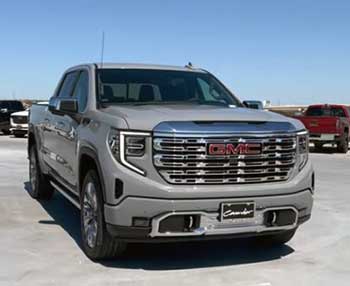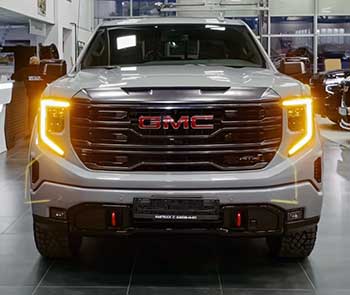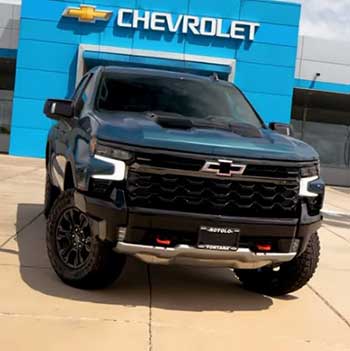
As a truck enthusiast, I’ve spent countless hours behind the wheel of both the GMC Sierra 1500 and the Chevrolet Silverado 1500, two heavyweights in the full-size pickup arena.
My goal is to break down their similarities, differences, and unique quirks to help you decide which truck fits your lifestyle. From towing capacity to interior luxury, I’ll share my firsthand insights, weighing pros and cons with a detailed comparison table.
Whether you’re hauling gear or cruising highways, this guide aims to steer you toward the right choice with clarity and a touch of personality.
| Feature | GMC Sierra 1500 | Chevrolet Silverado 1500 |
|---|---|---|
| Base Price (2025) | $38,945 | $37,000 |
| Engine Options | 2.7L Turbo I-4, 5.3L V-8, 6.2L V-8, 3.0L Duramax Diesel | 2.7L Turbo I-4, 5.3L V-8, 6.2L V-8, 3.0L Duramax Diesel |
| Max Towing Capacity | 13,200 lbs (6.2L V-8 or 3.0L Diesel) | 13,300 lbs (6.2L V-8 or 3.0L Diesel) |
| Max Payload Capacity | 2,240 lbs | 2,260 lbs |
| Fuel Economy (Combined) | 16-24 mpg | 18-22 mpg |
| Trim Levels | 8 (Pro, SLE, Elevation, SLT, AT4, AT4X, Denali, Denali Ultimate) | 9 (Work Truck, Custom, Custom Trail Boss, LT, RST, LT Trail Boss, LTZ, ZR2, High Country) |
| Standard Infotainment | 7.0-inch touchscreen (base); 13.4-inch touchscreen (higher trims) | 7.0-inch touchscreen (base); 13.4-inch touchscreen (higher trims) |
| Unique Features | MultiPro Tailgate, CarbonPro Bed, massaging seats (Denali Ultimate) | Multi-Flex Tailgate, more trim options, Realtree Special Edition |
| Standard Safety | Automatic emergency braking, lane-keeping assist, blind-spot monitoring | Automatic emergency braking, lane-keeping assist, blind-spot monitoring, Teen Driver technology |
| Interior Luxury | Premium materials (leather, wood accents in Denali trims) | Functional, with leather and wood in higher trims (High Country) |
My Experience With The GMC Sierra 1500
Driving the GMC Sierra 1500 feels like slipping into a well-tailored suit with a bit of rugged charm. My first test was a 2025 Sierra Denali Ultimate, and I was immediately struck by its upscale vibe.
The cabin’s open-pore wood and leather screamed luxury, almost making me forget I was in a pickup. On the highway, the 6.2-liter V-8 delivered a robust 420 horsepower, making passing slower traffic effortless.
I towed a 10,000-pound trailer with ease, and the MultiPro Tailgate’s six configurations were a game-changer for loading gear. Off-road, the AT4X trim handled rocky trails with confidence, thanks to its skid plates and all-terrain tires.
However, the Sierra’s ride can feel stiff on uneven roads, especially in the AT4 models. I noticed the base Pro trim’s 7.0-inch touchscreen felt dated compared to the higher trims’ 13.4-inch display.
Fuel economy wasn’t stellar either—my 5.3-liter V-8 averaged 17 mpg combined, which stung at the pump. The Sierra’s premium positioning also comes with a higher price tag, starting at $38,945, which might not suit budget-conscious buyers. Still, its blend of capability and refinement kept me impressed, especially for long drives or heavy-duty tasks.
I took the Sierra on a 500-mile road trip, and the adaptive cruise control made highway stretches a breeze. The Denali’s massaging seats were a surprising treat, though I wished they were available on more trims. Parking in tight spaces was less stressful with the 14 camera views, a feature that proved invaluable when maneuvering around crowded lots.
The Sierra’s bold grille and sharp lines turned heads, but I wondered if its upscale approach justified the cost over its Chevy cousin.
My Experience With The Chevrolet Silverado 1500
The Chevrolet Silverado 1500, on the other hand, feels like a trusted workhorse with a knack for versatility. I drove a 2025 Silverado High Country, and its 13.4-inch touchscreen with Google Built-In was intuitive and responsive.
The 3.0-liter Duramax diesel engine, with 305 horsepower and 495 pound-feet of torque, towed 13,300 pounds without breaking a sweat. The Multi-Flex Tailgate offered similar functionality to the Sierra’s but wasn’t standard across all trims. Off-road, the ZR2 trim’s suspension soaked up bumps better than expected, though it sacrificed some towing capacity at 9,000 pounds.
The Silverado’s ride quality stood out as smoother than the Sierra’s, especially on city streets. Its starting price of $37,000 makes it more accessible, and the nine trim levels offer something for everyone, from the no-frills Work Truck to the plush High Country. However, the base model’s vinyl seats and basic tech felt underwhelming.
I also noticed the Silverado’s exterior design, while bold, lacks the Sierra’s refined edge. Fuel economy was a bright spot—my 2.7-liter turbo averaged 20 mpg combined, better than the Sierra’s equivalent.
I used the Silverado for a weekend camping trip, hauling gear and navigating forest trails. The Teen Driver technology was a nice touch for families, letting me set speed limits for younger drivers.
The Realtree Special Edition’s camo accents added a fun, rugged flair, but I wished the base trims had more standard tech. Overall, the Silverado felt like a practical choice for those who want capability without the premium price.
Pros Of The GMC Sierra 1500
- Luxurious Interior: The Sierra, especially in Denali and Denali Ultimate trims, offers premium materials like full-grain leather and open-pore wood, creating a near-luxury SUV feel.
- MultiPro Tailgate: This innovative tailgate with six functions makes loading and unloading a breeze, from acting as a workbench to providing easy bed access.
- Strong Towing Capacity: With a max towing of 13,200 pounds (6.2L V-8 or diesel), it handles heavy trailers confidently, ideal for work or recreation.
- Advanced Tech Options: Higher trims feature a 13.4-inch touchscreen, Google Built-In, and up to 14 camera views, enhancing connectivity and trailering.
- Off-Road Prowess: The AT4 and AT4X trims come with skid plates, all-terrain tires, and an off-road package, making them excellent for rugged adventures.
- Premium Styling: The Sierra’s bold grille and sharp lines give it a sophisticated, upscale look that stands out in a crowd.
The Sierra’s luxury focus makes it feel like a step above typical pickups. I particularly loved the Denali Ultimate’s massaging seats, a rare feature in this class. The MultiPro Tailgate was a standout during a home renovation project, letting me use it as a step or workbench. Off-road, the AT4X tackled muddy trails with ease, and the 14 camera views made hitching a trailer simple. However, the premium features come at a cost, and not all trims get the full tech suite, which might disappoint budget buyers.
Cons Of The GMC Sierra 1500

- Higher Price Point: Starting at $38,945, the Sierra is pricier than the Silverado, and top trims like Denali Ultimate can exceed $80,000.
- Stiff Ride Quality: Especially in AT4 models, the suspension feels rough on uneven roads, less comfortable for daily driving.
- Mediocre Fuel Economy: Combined mpg ranges from 16-24, with the 5.3L V-8 averaging around 17 mpg, lagging behind competitors like the Ford F-150.
- Base Trim Lacks Tech: The Pro trim’s 7.0-inch touchscreen and wired Apple CarPlay/Android Auto feel outdated compared to higher trims.
- Limited Standard Features: Features like the MultiPro Tailgate and advanced safety tech are optional or exclusive to higher trims, increasing costs.
- Heavier Curb Weight: The Sierra’s weight (4,290 lbs base) slightly impacts fuel efficiency and agility compared to the Silverado.
The Sierra’s premium positioning means you pay more upfront, which might not suit everyone. During my test drives, the AT4’s stiff ride was noticeable on bumpy backroads, making it less ideal for daily commutes. The base Pro trim felt bare-bones, lacking the tech punch of competitors’ entry-level models. Fuel costs added up quickly with the V-8, and I wished features like the MultiPro Tailgate were standard across more trims. Still, the Sierra’s upscale appeal makes it a strong contender for those prioritizing luxury.
Read more: My Thoughts on GMC Terrain Vs. Ford Escape
Maintenance Tips For The GMC Sierra 1500
- Regular Oil Changes: Change the oil every 7,500 miles or as indicated by the oil life monitor to keep the engine running smoothly, especially for the 2.7L turbo or 6.2L V-8.
- Tire Rotations: Rotate tires every 6,000-8,000 miles to ensure even wear, particularly if you frequently tow or drive off-road with the AT4 or AT4X.
- Check Transmission Fluid: Inspect and replace transmission fluid every 45,000 miles to maintain smooth shifting in the 8- or 10-speed automatic.
- Brake Inspections: Check brake pads every 25,000 miles, as heavy towing can accelerate wear, ensuring safe stopping power.
- Air Filter Replacement: Replace the engine air filter every 15,000-30,000 miles, especially in dusty off-road conditions, to optimize performance.
- Coolant System Maintenance: Flush and replace coolant every 150,000 miles or as recommended to prevent overheating in the Duramax diesel.
Keeping the Sierra in top shape is straightforward but critical for longevity. I learned the hard way that skipping tire rotations led to uneven wear during off-road trips. Regular oil changes kept my 6.2L V-8 purring, and checking the transmission fluid prevented sluggish shifts. Brake inspections are a must if you tow heavy loads, as I noticed faster pad wear after hauling a trailer. The air filter needs frequent checks if you’re in dusty areas, and coolant maintenance is key for the diesel’s efficiency. Following these steps ensures the Sierra stays reliable for years.
Pros Of The Chevrolet Silverado 1500
- Lower Starting Price: At $37,000, the Silverado is more budget-friendly, making it accessible for a wider range of buyers.
- Higher Towing Capacity: With a max towing of 13,300 pounds (6.2L V-8 or diesel), it slightly edges out the Sierra for heavy-duty tasks.
- Smoother Ride Quality: The suspension offers a more comfortable ride, especially on city streets or long highway drives.
- More Trim Options: Nine trims, including unique ones like ZR2 and Realtree Special Edition, cater to diverse needs and styles.
- Better Fuel Economy: The 2.7L turbo achieves up to 20 mpg combined, outperforming the Sierra’s equivalent engine.
- Teen Driver Technology: This feature, unique to Chevy, allows parents to set speed limits and monitor driving habits for added safety.
The Silverado’s value and versatility shine through. I appreciated the lower starting price, which left room in my budget for upgrades. Towing a 12,000-pound trailer felt effortless with the diesel, and the ride was noticeably smoother than the Sierra’s on rough roads. The variety of trims meant I could pick a rugged ZR2 or a stylish High Country. Teen Driver tech was a bonus for my family, and the fuel savings with the 2.7L turbo were noticeable. The Silverado feels like a practical, all-around winner for work and play.
Cons Of The Chevrolet Silverado 1500

- Basic Base Trim: The Work Truck’s vinyl seats and 7.0-inch touchscreen lack the polish of higher trims or the Sierra’s base model.
- Less Premium Styling: The Silverado’s boxy design feels more utilitarian than the Sierra’s refined, upscale look.
- Fewer Luxury Features: Features like massaging seats or the CarbonPro bed are exclusive to the Sierra, limiting high-end options.
- Multi-Flex Tailgate Not Standard: Unlike the Sierra’s MultiPro, this versatile tailgate is optional, adding to costs.
- Lower Resale Value: The Silverado typically holds slightly less value than the Sierra, impacting long-term investment.
- Interior Noise: The cabin can be noisier than the Sierra’s, especially at highway speeds with the V-8 engines.
The Silverado’s no-nonsense approach has downsides. The Work Truck trim felt spartan, with cheap materials that didn’t inspire confidence. Its exterior, while bold, lacks the Sierra’s sleekness, and I missed luxury touches like massaging seats. The optional Multi-Flex Tailgate was handy but added to the price, and road noise was noticeable on long drives. Resale value concerns also lingered, as the Sierra tends to hold its worth better. Still, the Silverado’s capability and affordability make it a solid choice for practical buyers.
Read more: My Thoughts Acura Integra Vs. Honda Accord
Maintenance Tips For The Chevrolet Silverado 1500
- Oil Changes: Change oil every 7,500 miles or per the oil life monitor to ensure engine health, especially for the 3.0L diesel or 5.3L V-8.
- Tire Maintenance: Rotate tires every 6,000-8,000 miles and check alignment, crucial for towing or off-road use with the ZR2.
- Transmission Care: Check and replace transmission fluid every 45,000 miles to maintain the 8- or 10-speed automatic’s performance.
- Brake System Checks: Inspect brake pads every 25,000 miles, as heavy towing can cause faster wear, ensuring safety.
- Air Filter Replacement: Swap out the air filter every 15,000-30,000 miles, particularly in dusty conditions, to boost efficiency.
- Coolant Flush: Replace coolant every 150,000 miles to prevent engine overheating, especially with the Duramax diesel.
Maintaining the Silverado is similar to the Sierra but just as essential. I found regular oil changes kept the diesel engine running smoothly, while tire rotations saved me from premature replacements after off-road adventures. Transmission fluid checks prevented jerky shifts, and brake inspections were critical after towing heavy loads.
The air filter needed frequent attention in dusty areas, and a coolant flush ensured the engine stayed cool during long hauls. These steps kept my Silverado reliable, whether for work or weekend getaways.
Frequently Asked Questions (FAQ)
It depends on your priorities. The Sierra offers a more luxurious interior and unique features like the MultiPro Tailgate, but the Silverado has a lower price, slightly better towing, and more trims.
GMC’s higher trims, like Denali, use premium materials, giving a slight edge in perceived quality. However, both trucks share the same platform and components, so build quality is nearly identical.
Both are built on the same GM platform with similar engines, so longevity is comparable. With proper maintenance, either can last over 200,000 miles, depending on usage and care.
Avoid the 2016-2018 Silverado models, as some had issues with transmission reliability and electrical glitches, reported in owner forums and recalls. Newer models are more refined.
Conclusion: For GMC Sierra 1500 And Chevrolet Silverado 1500
You’re now armed with the full scoop on the GMC Sierra 1500 and Chevrolet Silverado 1500. If you crave luxury and unique features like the MultiPro Tailgate, the Sierra’s premium vibe might be your pick, though it comes at a higher cost and a stiffer ride. If value, versatility, and a smoother drive are your priorities, the Silverado’s lower price and extra trim options make it a compelling choice.
Both trucks excel in towing and capability, so test-drive them to feel the difference. Your perfect pickup depends on your needs—choose wisely and hit the road with confidence.

